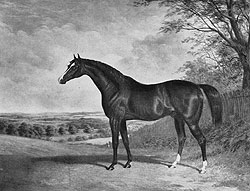|
Notes l Bibliography l Download Issue 2 
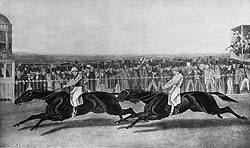 |
A thoroughbred race, from William R. Woodard, Cherished Portraits of Thoroughbred Horses (Privately printed, Ernest R. Gee, 1929)
|
Set in 1888, "The Adventure of Silver Blaze" is an early Sherlock Holmes story from the first year of Conan Doyle's fame. Although Conan Doyle was a sporting man, he knew little about horseracing, and mistakes in terminology and racing customs abound. Despite these small faults, the central mystery is gripping, and some favorite sayings of Sherlock Holmes originate here.
"The Adventure of Silver Blaze" (1)
A blaze is a long white characteristic mark down the nose of a horse. Silver Blaze's name might also imply something about the horse's speed.
"To Dartmoor–to King's Pyland." (1)
Dartmoor, a granite plateau stretching over hundreds of acres through Devon in the southwest of England, is a windswept wilderness of peat bogs and granite outcroppings. Sheep and wild ponies run free, although the extreme weather conditions make life difficult for animals, and even for plants. (See our archived issues of The Hound of the Baskervilles for pictures and more information.)
King's Pyland Stables and the Wessex Cup are fictional, but several racetracks and many stables are located in Devon, on the outskirts of the moor. The fictional King's Pyland, and its nearest town, the very real Tavistock, lie to the west of Dartmoor.
"...just time to catch our train at Paddington...." (1)
Paddington Railway Station is located northwest of Regent's Park, and is a hub for trains traveling to the southwest of England.
"...your very excellent field-glass." (1)
Holmes wants Watson to bring along his binoculars.
"...en route for Exeter...." (1)
A city in Devon, about 40 miles east of Tavistock.
...while Sherlock Holmes, with his sharp, eager face framed in his earflapped travelling cap.... (1)
Conan Doyle only mentions Holmes's "earflapped travelling cap" once. But Sidney Paget interpreted that cap as a deerstalker (see illustrations on page 2, 6, 10, and 12), and, ever since, Holmes has been envisioned by millions of readers as a man chronically addicted to eccentric headwear.
We had left Reading far behind us.... (1)
Reading is about 40 miles west of London.
"Our rate at present is fifty-three and a half miles an hour."
"I have not observed the quarter-mile posts," said I.
"Nor have I. But the telegraph posts upon this line are sixty yards apart, and the calculation is a simple one." (1)
The rough calculation of distance divided by time equals speed is fairly simple, provided that the train is traveling at a constant speed–but getting an answer accurate to a half a mile per hour is not simple at all. Many methods have been proposed for Holmes to do this calculation on the fly, the most ingenious of which involve counting telegraph poles for a specific amount of time, and comparing the result to what would happen if the train were traveling at 60 mph. Considering that the calculation is so complex, I would rather conjecture that Holmes observed the time it took to pass one or two poles, did a rough calculation, and threw in the extra half a mile per hour to impress Watson.
"I have seen what the Telegraph and the Chronicle have to say." (1)
The Daily Telegraph was founded in 1855, and today is one of the few remaining large-format–"broadsheet"–newspapers in England. In 1857, it began using the "box number" system for personal advertisements, so dear to Sherlock Holmes's (and Conan Doyle's) heart because it allowed anonymous postings with replies directed to the box number. Soon other newspapers took up this excellent system. Personal ads and reply boxes figure in a number of Sherlock Holmes's adventures. The photograph below of Conan Doyle's home Undershaw comes from the on-line version of the Daily Telegraph.
The Daily Chronicle was published from 1872 to 1930.
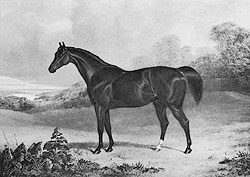 |
|
|
| Whalebone and Camel, two ancestors of Isonomy, an actual racehorse, and of the fictional Silver Blaze. Note the blaze on Camel's nose. From William R. Woodard, Cherished Portraits of Thoroughbred Horses (facing pages 161 and 165) |
"...is from the Isonomy stock...." (2)
Born in 1875, Isonomy (sired by Sterling, out of Isola Bella) was a successful racehorse who sired two English Triple Crown winners and several famous sire sons. From the ancient Greek, the word "isonomy" means "equality under the law."
"He is now in his fifth year, and has brought in turn each of the prizes of the turf to Colonel Ross, his fortunate owner." (2)
The racing career of a thoroughbred usually starts when the animal is two years old. The career peak is usually reached between three and five years of age, and, by five or six, the animal has been retired to stud or retrained as a polo pony or jumper. In Conan Doyle's day, racing careers lasted longer, although horses were usually retired well before age 10, at which point they were put out to stud, in the hopes of passing on their best characteristics to a new generation of thoroughbreds.
"Each of the prizes of the turf" is vague, but implies that Silver Blaze is a British Triple Crown winner.
"...a retired jockey, who rode in Colonel Ross's colours before he became too heavy for the weighing chair." (2)
Each stable has its own colors, worn by the jockeys who ride for it. These bright outfits are known as "silks."
Before and after each race, the jockey and the saddle are weighed together. Horses are given extra weight, or handicaps, in the form of lead weights inserted into the saddle, according to their racing records.
"...a Tavistock contractor...." (3)
Tavistock is an ancient town, with a population of about 11,000, located on the River Tavy, at the western edge of Dartmoor.
"...inhabited only by a few roaming gipsies." (3)
As always, "gipsies" are convenient, and much maligned, suspects in any mischief. "Gipsies" (or "gypsies") usually refers to the Roma people, who originated in India, but might alternatively refer to the "Irish Travelers," or "Pavee," nomadic Irish people who wander through Great Britain.
"...he wore gaiters...." (3)
"Gaiters" are leather sheaths that protect the shoes from mud, rain, etc. A country gentleman and horse-owner (like Colonel Ross) might be expected to wear them.
"...out of his waistcoat pocket." (3)
A "waistcoat" (pronounced "weskit") is a vest meant to be worn with a suit jacket. It contains tiny pockets, suitable for a pocket watch or other small objects.
"'Is it a fact that at the weights Bayard could give the other a hundred yards in five furlongs...?'" (4)
A furlong is an eighth of a mile, or 220 yards. The man seems to be asking if the King's Pyland stablehands themselves believe that Bayard could lose to the favorite, Silver Blaze, by a hundred yards in five furlongs even though the latter's handicap weight is so much greater.
"'So you're one of those damned touts,' cried the lad." (4)
"Tout" is a general term for a promoter. In horseracing, a tout buys and sells advance information about a horse or a race. In this case, the gentleman seems more worried about his own investment than about selling information to others.
"...who slept in the chaff-cutting loft above the harness-room...." (4)
Chaff is chopped-up straw and wheat husks, used for livestock feed.
"...flapping from a furze bush." (5)
"Furze," also known as "gorse" or "broom," is a wild plant that bears yellow flowers in spring.
"...a red and black silk cravat...." (5)
A forerunner of the modern necktie, a "cravat" would consist of a thicker piece of fabric.
"...by doing a little quiet and genteel bookmaking in the sporting clubs of London." (5)
"Bookmaking" is illicit betting. The "sporting clubs of London" would have been gentleman's clubs that concentrated on sport.
"...and his stick, which was a Penang lawyer, weighted with lead, was just such a weapon as might, by repeated blows, have inflicted the terrible injuries to which the trainer had succumbed." (5)
Straker's walking stick is made from the wood of a palm from Penang, formerly a British colony and now part of Peninsular Malaysia. Weighted with lead, the bulbous head of the hardwood stick would have made a dangerous weapon.
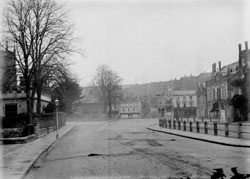 |
Bedford Square in Tavistock in 1895, photographed by Taylor (ref. # DA-002216). At center left, between the trees, the arches of the railway station are barely visible.
|
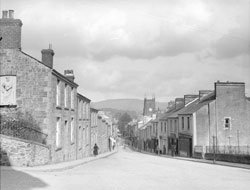 |
West Street in Tavistock before 1920, photographed by Taylor, ref. # DA-002197.
Original Images © Devon County Council, Web Image © Dartmoor Archive. Used by permission. |
...the little town of Tavistock, which lies, like the boss of a shield, in the middle of the huge circle of Dartmoor. (6)
In fact, Tavistock is just on the western boundary of Dartmoor, and nowhere near its middle.
...with trim little side-whiskers and an eye-glass. (6)
"Side-whiskers" are sideburns. An "eye-glass," also known as a monocle, was a corrective lens worn only in one eye and secured by the pressure of the eye socket itself. A chain attached the eyeglass to the wearer's vest. Often associated with wealth and privilege in Victorian times, today, monocles have become a symbol of affectation.
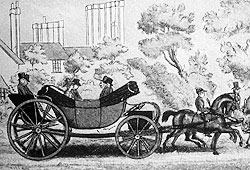 |
A 19th-century landau from Hilaire Belloc's The Highway and Its Vehicles (London: Studio Limited, 1926) plate XL. See also the illustration on page 12 of the story.
|
A minute later we were all seated in a comfortable landau.... (6)
A landau is a four-wheeled carriage that seats four, and is unique for its two folded coverings (each one resembling the folded roof of a convertible car) that meet in the middle.
"He says that it was a ten-pound note." (7)
Since the stable boy's weekly salary was probably somewhat less than 20 shillings a week (about one pound), this is a considerable bribe.
There was a box of vestas, two inches of tallow candle, an A.D.P. briar-root pipe, a pouch of sealskin with half an ounce of long-cut Cavendish, a silver watch with a gold chain, five sovereigns in gold, an aluminium pencil-case, a few papers, and an ivory-handled knife with a very delicate inflexible blade marked Weiss and Co., London. (7-8)
Vestas are strike-anywhere matches made of wax. If any kind of match could be struck in the rain, it would be a vesta.
A tallow candle is made from rendered animal fat.
"A.D.P." refers to a brand of briar-root pipe manufactured during Conan Doyle's time. Briar pipes are made, not from briars, but from burls found on the roots of a variety of Mediterranean heather.
Cavendish was a brand of tobacco, sold in cakes.
Introduced in 1816, the gold sovereign pictures the reigning monarch on one side, and Saint George slaying the dragon on the other. Five gold sovereigns would have a face value of £5, or anywhere from approximately $350 to thousands in today's American currency, depending on whether the calculation is done relative to buying power, earning power, as a fraction of gross domestic product, etc. (See "Measuring Worth.com" for more information on this fascinating topic) Since Straker's yearly salary might have been somewhere in the neighborhood of £500, give or take a hundred, £5 would have been about half of his weekly salary.
John Weiss & Son was a maker of fine surgical instruments located in London, first at No. 62, Strand, and later at No. 287, Oxford Street.
"...a milliner's account for thirty-seven pounds fifteen, made out by Madame Lesurier, of Bond Street...." (8)
Millinery refers to hatmaking (and, in the 19th century, also to dressmaking). The bill is rather high for someone with Straker's probable income. "Bond Street" is still a fashionable address for designer clothing, although Madame Lesurier's shop is fictional.
"Twenty-two guineas is rather heavy for a single costume." (8)
A pound used to equal 20 shillings, but a guinea was worth 21. Although gold guineas were not minted past the first decade of the 19th century, the term continued to be used in commerce and wagering, especially when large sums of money were involved. Thirty-seven pounds, fifteen shillings, is worth about 36 guineas, of which more than half was spent on one outfit.
"Surely I met you in Plymouth, at a garden party...." (8)
In his concentration upon the facts of the case, Holmes fails to respond to the lady's obvious grief-stricken state.
Plymouth is about 15 miles due south of Tavistock.
He took the boots from the bag and compared the impressions of each of them with marks upon the ground. (9)
In Conan Doyle's time, forensic science was in its infancy, and some of the techniques used by Holmes were only starting to be adopted by police departments. See E.J. Wagner, The Science of Sherlock Holmes: from Baskerville Hall to the Valley of Fear, the Real Forensics behind the Great Detective's Greatest Cases (Hoboken, N.J.: John Wiley & Sons, 2006).
"We imagined what might have happened, acted upon the supposition, and find ourselves justified." (10)
"It is a capital mistake to theorize in advance of the facts," says Holmes in "The Second Stain."
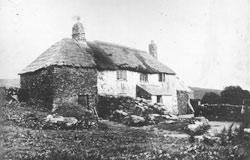 |
Teignhead Farm, a lonely Dartmoor farmstead, about 10 miles northeast of Tavistock, built in the 18th century and photographed in 1889 by Robert Burnard (ref. # DA-003223).
|
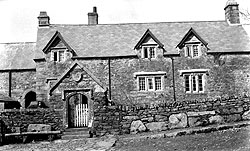 |
Hall farm, in Sampford Spiney, within 5 miles of Tavistock, was built in 1607 and photographed by Taylor in 1917 (ref. # DA-000432). |
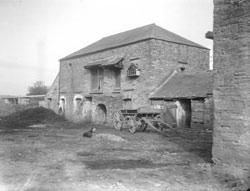 |
Taylor photographed the barnyard of the Old Barton Farm, Horrabridge, in 1914 (ref. # DA-000370).
Original Images © Devon County Council, Web Image © Dartmoor Archive. "The Dartmoor Archive." Used by permission |
It ended at the paving of asphalt which led up to the gates of the Mapleton stables. (10)
Old Dartmoor farmsteads are not as grand as one might imagine from the story. Some examples are shown below at left.
"Oh, you can trust me, you can trust me!"
"Yes, I think I can." (11)
In later editions, these lines were interposed between the lines above:
"You must see to it on the day as if it were your own."
"You can rely upon me."
"...the Colonel's manner has been just a trifle cavalier to me." (11)
Sherlock Holmes does not suffer slights happily, and sees no need to turn the other cheek. When he sees that a client does not have confidence in his deductions, he is often inclined to treat the client somewhat cruelly.
I was about to make some reply in defence [sic] of my friend.... (12)
Holmes sometimes likes to make people underestimate him so that they will be even more amazed when he is proven right. Watson is often in danger of destroying Holmes's ruse, so eager is he to stand up for his friend.
"To the curious incident of the dog in the night-time."
"The dog did nothing in the night-time."
"That was the curious incident," remarked Sherlock Holmes. (13)
This "Sherlockism" has been quoted endlessly to indicate a situation where a lack is more significant than a positive action. A recent book, The Curious Incident of the Dog in the Night-Time (New York: Doubleday, 2003), by Mark Haddon, concerns an autistic teen who sets out to solve a crime.
 |
The race for the Doncaster Cup in 1826, from William R. Woodard, Cherished Portraits of Thoroughbred Horses (Privately printed, Ernest R. Gee, 1929), facing page 117
|
 |
| A private coach, or "drag," from Hugh McCausland, The English Carriage (London: Batchworth Press, 1948) plate XXV, facing page 112 |
...Holmes and I were again in the train bound for Winchester, to see the race for the Wessex Cup. (13)
Located about 160 miles east of Tavistock, Winchester is the capital of Hampshire, the county east of Devon. In ancient times it was the capital of Wessex, one of the seven Anglo-Saxon kingdoms (hence Conan Doyle's fictitious name for the race, the "Wessex Cup," or "Plate").
...we drove in his drag.... (13)
A "drag" was a small, covered coach for private, rather than public, use.
"...his mottled off fore leg." (13)
The "off" leg is the right, while the "near" is the left, since riders customarily mount from the left side of a horse.
"You could have got fifteen to one yesterday, but the price has become shorter and shorter, until you can hardly get three to one now." (13)
"Fifteen to one" is the calculated odds against a horse winning, based on its record and on how heavily people are betting on the horse. If the horse wins, a successful bettor would win fifteen pounds for every pound bet. A horse rated at three to one would be more likely to win than a horse rated at fifteen to one, and thus the payoff would be less.
As the odds drop, Holmes comments that "someone" must know that Silver Blaze is actually in the running. People apparently have been betting large amounts on him, driving down the odds. Some commentators suspect that Holmes himself has placed a bet upon Silver Blaze, and thus stands to profit improperly from his own trick.
Wessex Plate. 50 sovs. each, h ft, with 1,000 sovs. added, for four and five-year olds. Second £300. Third £200. New course (one mile and five furlongs). (13)
Conan Doyle is trying to reproduce the information given in a racing program. The epithet "plate" indicates a race with a fixed prize, rather than one drawn from the entry fee, or "stakes," paid by the owners. He lists the prizes for first, second, and third place, as well as the ages of horses that may compete and the length of the course.
Colonel Ross's Silver Blaze (black cap, red jacket). (13)
These are the colors of the colonel's silks; the jockey wears these colors to represent the King's Pyland stables.
"We scratched our other one...." (13)
The colonel is saying that he took his other horse–Bayard–out of the race.
"Five to four against Silver Blaze!" (13)
These odds indicate that Silver Blaze is favored to win. For every four dollars bet, a successful bettor would win only five–not a very favorable payoff.
"...wash his face and his leg in spirits of wine...." (13)
"Spirits of wine" is brandy, which is distilled from wine.
"Sometimes it is a pulling jockey." (15)
A "pulling jockey" holds his horse back deliberately to make it lose, usually for a bribe.
"...it is possible to make a slight nick upon the tendons of a horse's ham...." (15)
The horse's ham is the thick area just above its knee.
"...we shall be in Victoria in less than ten minutes." (16)
Homes and Watson actually should be returning to London from Winchester via Waterloo Station, not Victoria, which did not serve the southwest of England.
 |
Undershaw as it appears today. Photograph courtesy of The Daily Telegraph 2006/Geoff Pugh
|
Although his mother, Mary Foley Doyle, claimed to trace her lineage back to the royal Plantagenets through her mother's side, and loved to tell her eldest child tales of British history, Conan Doyle wasn't royalty, by any stretch of the imagination. When he became a wealthy man, he had to create his own estate.
The fate of Conan Doyle's home from 1896 to 1906, which he had a minor hand in designing, is still in doubt. After learning in 1893 that his wife Louise ("Tooie") might not live out the year, Conan Doyle first took her to Switzerland, whose dry air and high altitudes were more healthful for consumptives than the damp climate of England. When friends told him about the mild, dry microclimate of Hindhead, Surrey, he decided to build a home there. In 1895, Conan Doyle bought land and chose an architect to build Undershaw. Under her husband's watchful care, Tooie lived another decade, and died at Undershaw in 1906.
While the red brick house is less than an architectural marvel, it bears the imprint of Conan Doyle's character. Doors are doubled-hinged, to accommodate a large man with an energetic stride who couldn't stop to turn a knob or pull a door towards him. Stained-glass panels show the coats of arms of Mary Foley Doyle's venerable family, and doors are monogrammed with Conan Doyle's initials. Conan Doyle wrote both The Hound of the Baskervilles and The Empty House at Undershaw.
A developer first planned to convert the home into 13 apartments, but has compromised at four. Conservationists want the home listed as a Grade I English Heritage Property, which would preserve it as a single-family dwelling with some public access. But there are problems: the house spent many years as a hotel-restaurant, and has been abandoned since 2004. Vandals have left it open to the elements, and, according to recent reports, have destroyed some of the architectural features. The appropriate government agencies are assessing the application for historical preservation now. Undershaw might not survive the wait.
|




